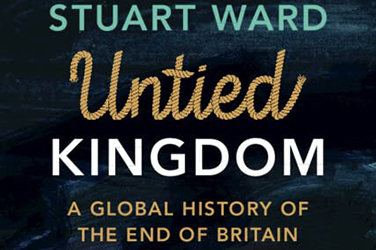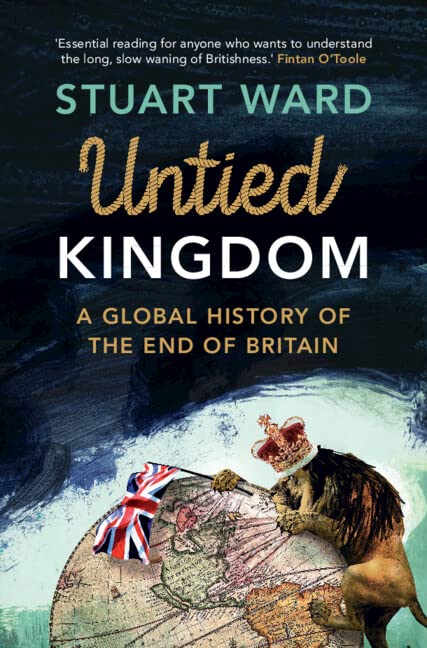
- Free Article: No
- Contents Category: History
- Review Article: Yes
- Article Title: House of cards
- Article Subtitle: A panoramic view of ‘Greater Britain’
- Online Only: No
- Custom Highlight Text:
Two of my favourite images in Stuart Ward’s important new book reproduce black-and-white photographs. One captures the life-sized butter sculpture of the prince of Wales and his favourite Canadian horse, the star exhibit of the 1924 Empire Exhibition at Wembley. The other shows a group of protesters in London in 1973 contesting European Economic Community restrictions on imports of Commonwealth cane sugar from the West Indies and Queensland. Most of the faces in the picture are obscured, but the body language of a man to the left of the frame, slumped over his hand-rendered ‘Beat Beet. Keep Cane’ placard, communicates depression and dejection.
- Featured Image (400px * 250px):

- Alt Tag (Featured Image): Gordon Pentland reviews 'Untied Kingdom: A global history of the end of Britain' by Stuart Ward
- Book 1 Title: Untied Kingdom
- Book 1 Subtitle: A global history of the end of Britain
- Book 1 Biblio: Cambridge University Press, £30 hb, 700 pp
- Book 1 Cover Small (400 x 600):

- Book 1 Cover (800 x 1200):

In contrast, Ward is concerned to embrace the fuzzy edges and the grey zones of this expansive idea of Britain. All parts of Britain’s global footprint before the later twentieth century are potentially ‘in’, and it is the very imprecision and bagginess of the term which is attractive to Ward, as he adopts a sampling approach. As the prologue makes plain, different versions of this memetic form of imperial Britishness were developed within, and to suit, different imperial contexts. In spite of its clear racial connotations, its edges were blunted by the perceived need to sustain two important fictions under ‘conditions of active deployment’: first, that empire was mainly about liberty; second, that British understandings of liberty involved the toleration and management of difference and were thus a stark contrast to the ‘bad’, authoritarian, and more ostentatiously racial ideas underpinning empires of less liberty-loving global actors.
This in turn ensured that Greater Britain – while always ready to surface in exclusive and racialised forms – could also offer languages of rights and citizenship that were theoretically accessible to all subjects. It was a politically usable creation, and Ward shows just how creatively it was used in his fascinating treatment of the 1914 arrival of the ship Komagata Maru in Vancouver. The 376 male Punjabi Sikhs aboard were well aware of the utility of the softer version of Greater Britain: ‘We are British Citizens and we consider we have a right to visit any part of the Empire.’ In another example, the famous Indigenous activist William Cooper was even pithier: ‘We ask the right to be fully British.’
If conceptual inexactness was broadly advantageous before the turning point of World War II, in many ways it became a liability in the decades that followed. In six chapters that form the core of Ward’s multi-sited global unravelling of Greater Britain, forced efforts to pin down or more closely define its central features were conspicuous failures. Vague notions about the rights of British subjects lost out to the more confident language of universal human rights which was sweeping all before it after 1945. When Canada (with some controversy and breast-beating) relegated imperial subjecthood to be a function of Canadian citizenship, or awkward attempts were made to include India as a republican state in the Commonwealth, definitions were required, which threatened to bring the whole house of cards tumbling down.
Perhaps what is most impressive is that, across his panoramic sweep, Ward redeems his pledge to retain focus on the ‘affective ties’ that nourished Greater Britain and on their fate as it dissolved. The emotional content of imperial trade, for example, frames the images mentioned at the beginning of this review, the consequences of its undoing often most disruptive for those on the edges of the disintegrating world system. West Indian and especially Queensland sugar producers experienced these ‘dying convulsions of a discarded belief system’ acutely. In another fine chapter, Ward begins with Sagana Lodge in Kenya, a lavish wedding gift in 1947 and the only royal residence established outside the United Kingdom. It was an important venue on Elizabeth and Philip’s abortive 1952 world tour, and it is used expertly by Ward, both as a lightning rod for those emotive ideas about ‘home’ which underpinned settler colonialism and to explore their rapid and violent eclipse as the Mau Mau insurgency took off and, in some melodramatically publicised cases, violated these carefully crafted fantasies of domesticity.
Emotions are clear also in the final section of the book, whose chapters fold back in imperial and global concerns to enrich our narrative of postwar Britain and frame it around geopolitical retreat, escalating racial tension, a rich (and richly global) vein of declinist navel-gazing, and serious challenges to the territorial integrity of the UK state. This ‘Break-up of Britain’ – to use the name of Tom Nairn’s trenchant 1977 polemic, an inspiration for Ward, but also a product of the very processes he describes – has often been linked to empire. After all, there are few dissenters to Linda Colley’s influential account, which presented empire as one of the most effective building blocks of Britishness in the eighteenth century. It became almost intuitive to hold that the eclipse of empire helped to explain pressures on those unions and identities it had done so much to sustain. Ward’s great contribution is both to put some meat on the bones of this scholarly common sense and to do it in a way that retains the global focus of his book, rather than just zooming in to Britain’s crises.
Ward’s conclusions are admirably measured. The imperial dimension does not replace or trump existing explanations for the emergence of ‘the Troubles’ in Northern Ireland from the late 1960s or for the rapid electoral lift-off of separatist nationalisms in Wales and especially Scotland in the 1970s. All of these phenomena are enriched, however, by reading them alongside the painful unravelling of ‘Greater Britain’. Irish nationalism only became unreservedly anti-colonial in the context of the imperial politics of the 1960s, while Ulster unionist politics are illuminated by putting them in conversation with the obstructive Rhodesian empire loyalism, which British ministers were confronting within the same time frame. Such links were supple and multivalent. As Ward points out, the winners of the Carmarthen and Hamilton by-elections (1966 and 1967 respectively), Gwynfor Evans and Winnie Ewing, both received fan mail from Rhodesians, who equated their own struggles with Wilson’s Labour government with these emblematic nationalist election victories.
To point to omissions in a book of this depth and richness might seem churlish. Given its centrality to the forms of imperial Britishness that roared out of the eighteenth century and underpinned ‘Greater Britain’, religion is curiously sotto voce in Ward’s account. Predictably, it looms larger in the chapter on Ireland, but with the eventual evacuation of religion from British public life in the 1960s, even in terms of the broad chronology he traces, it feels like its systematic inclusion elsewhere might have been grist to Ward’s mill.
Finally, in such a large book, the ending, which covers the period from around 1980, is a bit of a mad dash. Even accepting Ward’s central theme that the disaggregation of Greater Britain was largely completed in the forty or so years after the fall of Singapore, I would have loved to read a bit more on what he makes of apparently similar Greater British themes in Brexit. On one hand, the boosterish face of the Leave campaign certainly bore a family resemblance to episodes such as the ‘I’m Backing Britain’ campaign of the late 1960s. There can be no doubt that, from start to finish, the 2016 referendum and its outcome were freighted with, even driven by, emotions. On the other, untying that mess might take another seven hundred pages. At least.


Comments powered by CComment